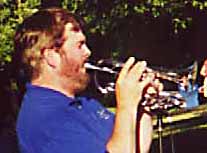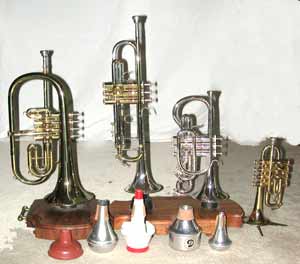
 |
Glen Newton plays a cornet solo during the Roseville Big Band's July 4, 2001, concert. The cornet was Glen's example of an instrument not often heard today as a part of big band jazz. |
Although the trumpet is the most common soprano brass instrument today, it was the cornet that dominated band music a century ago. In that era, trumpets were usually heard only in orchestras. (A letter from world-famous cornet soloist Herbert L. Clarke to Eldon Benge in 1921 illustrates his perception of the trumpet as "only a foreign fad for the time present," one that "is only used properly in large orchestras of 60 or more, for dynamic effects, and was never intended as a solo instrument.")
As late as the 1960's, school bands in the United States generally had far more cornets than trumpets. Band music was frequently written with three or four cornet parts and two trumpet parts. The cornets were expected to play the more technical flowery musical lines, comparable in some selections with level of difficulty of the clarinet parts, while the trumpets added a brilliant punctuation to the music, rarely playing legato passages.
However, jazz bands and dance orchestras of the 1930's and later brought the trumpet increasingly into the public's view, and as school dance bands sprang up across America, brass instrument manufacturers saw an opportunity. By making trumpets whose bore shape and bell flair was a cross between that of the turn-of-the-century trumpet and the cornet, they took some of the edge off the traditional trumpet tone and produced instruments that were suitable for all kinds of school music.
Gradually, thanks in part to these new trumpet designs, the composition of school brass sections changed to the extent that now it is very common for the section to be comprised entirely of trumpets, with not a single cornet in the entire band program. This change is also reflected in adult wind bands. A student or an adult amateur can play the same trumpet in the concert band, jazz band, and orchestra, producing a tone quality that today's audiences find pleasing in all of these ensembles.
On the other hand, most brass bands still use cornets for the highest parts, maintaining historically authentic instrumentation. In this type of instrumentation, often used in Salvation Army bands, the highest part is played by the lone E-flat cornet, pitched a perfect fourth (five half steps) above the more prevalent B-flat cornets; no trumpets are used.
Cornets are also commonly used in Dixieland or "traditional" jazz combos.
In the picture above, Glen Newton is playing a cornet that has a "shepard's crook" shape where the bell section joins the valve section. This traditional cornet shape, which also includes an extra bend that shortens the instrument's overall length, indicates that the instrument is a cornet. There is no inherent reason for this, since a trumpet could also be made in this shape; it's simply a convention. (An picture of an interesting 1883 jewelled cornet with shepard's crook is on the web site of The National Music Museum; although the modern cornet differs in several ways, the shepard's crook, when present in the design, still says, "This is a cornet.")
However, cornets are also made in other shapes, including the traditional trumpet shape, making it nearly impossible to tell at sight if one of these trumpet-shaped instruments is a cornet or a trumpet. For example, some of Conn corporation's cornet models were made in this trumpet shape. The company helped musicians tell the difference by stamping "A" on the leadpipe for cornets and "B" for trumpets; the "A" and "B" are also part of the model numbers.
The definitive difference is the bore shape, which in a cornet is roughly one-third cylindrical and two-thirds conical, and in a modern trumpet is roughly half cylindrical and half conical.
The differences in trumpet and cornet tone are subtle enough that they can easily be overshadowed by differences in mouthpieces, players, and room acoustics. Indeed, part of the traditionally mellower cornet tone is attributable to the mouthpiece shape. A cornet mouthpiece is usually somewhat more funnel-shaped than a trumpet mouthpiece, but this funnel is in the internal mouthpiece cavity and not visible to the audience.
The basic technique required for playing the cornet is the same as for the trumpet and the flugelhorn. The main exception to this generalization is that some flugelhorns and some high-pitched trumpets, such as the piccolo trumpet, have four valves, whereas cornets, like B-flat trumpets, have only three; using the fourth valve requires learning additional technique.
In the picture below, the instruments are, from left to right, flugelhorn, trumpet, cornet, and piccolo trumpet. The mutes, from left to right, are plunger, straight, cup, wa-wa, all for either cornet or trumpet, and a piccolo trumpet stright mute.
 |